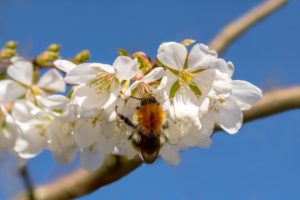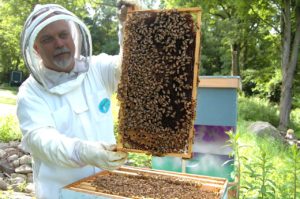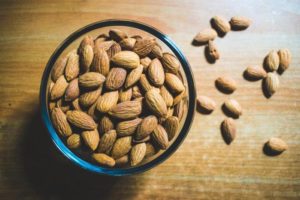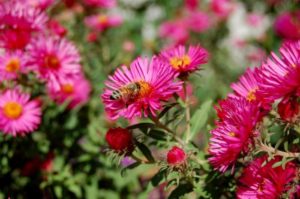What’s All the Buzz About Pollinators?
Trips to the garden center and articles about landscaping and edible gardening. Radio garden programs and school field trips. What do they have in common?
The subject of Pollinators will come up!
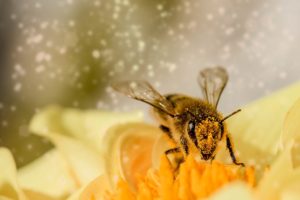 And for good reason: we rely on pollinators for more than a third of our entire food supply! Without the bees, butterflies, bats, and hummingbirds, we would not be able to feed our growing populations. Apple, peach, and nut trees, tomatoes and peppers. Zucchini, cucumbers, berry bushes, and farm animal feed. These are just a few crops that depend on these little critters. Trees, grasses, shrubs, and wildflowers also rely on pollinators for procreation.
And for good reason: we rely on pollinators for more than a third of our entire food supply! Without the bees, butterflies, bats, and hummingbirds, we would not be able to feed our growing populations. Apple, peach, and nut trees, tomatoes and peppers. Zucchini, cucumbers, berry bushes, and farm animal feed. These are just a few crops that depend on these little critters. Trees, grasses, shrubs, and wildflowers also rely on pollinators for procreation.
Pollinators are attracted to the flowers’ sweet nectar, for carbohydrates, and to pollen for proteins and lipids. Insects and other pollinators gather nectar and pollen from the flowers they visit. During this beneficial arrangement, called mutualism, they unintentionally transfer pollen grains from one flower to the next.
The Fruits of Pollination
Pollen (the male component) deposited onto a receptive stigma (female) in a flower belonging to the same species initiates the fruiting process. The half set of haploid chromosomes in ovules and sperm are recombined during fertilization. (This is not the kind of fertilization that involves nutrients). This restores the full diploid chromosome count. The ovary (fruit) grows and toughens, protecting the seeds until the fruits are harvested or the seeds dispersed.
Fruits, though, aren’t limited to the recognizable apples, peaches, and pears on a grocery store shelf. Botanically, a fruit is any seed- or spore-bearing structure in flowering plants and other organisms. This includes wheat, a kernel of corn, a plump blueberry, a sweet cherry, or an heirloom tomato. Even fungi, including mushrooms, have “fruiting bodies”.
Animals attracted to these nutritious fruits aid in seed dispersal, although in many cases, the seeds themselves are consumed and digested.
And there are some anomalies in Mother Nature’s kingdom that permit us to call strawberries “fruits” or “berries”, although they are neither! The luscious little strawberry is the swollen receptacle, the part that connects the flower to the stem. The actual fruits, or achenes, are those little brown things on the outside. And there’s a seed inside each achene.
No pollination means no fruit in up to 80% of our edible crops!
Honey Bees
Honey bees (Apis mellifera) are not native to the Americas. They originated in Africa and migrated to Indonesia, Europe, and Asia. The early colonists brought them here, where they proliferated throughout the frontier, preceding the settlers’ expansion into new territory. Before this species was imported, thousands of other types of insects and animals pollinated flowers. And they still do!
As the nation’s population grew, more crops entered cultivation. Agriculture became even more dependent upon these easily domesticated pollinators.
California’s almond harvest relies entirely on bee activity for nut production. In fact, beekeepers ship 75% of the country’s “beehives for hire” to flowering almond orchards to ensure a good crop.
Of the many thousands of bee species found worldwide, the honey bee is the only one that makes honey. Forager bees returning to the hive with nectar give this bounty to the processor bees. Processors pass the nectar among themselves, helping to lower the water content. Then they deposit the liquid into cells and fan it with their wings to concentrate the honey. After that, they cap the cells with wax to seal the compartment.
Forager bees mix their saliva with the pollen they collected, which the processors place in the cells. Once they’re capped, the mixture begins fermenting, resulting in a substance called bee bread. Both types of cells, with pollen and nectar, also contain enzymes from the bees. Nurse bees feed this bee bread to all larvae, and the colony can access it for sustenance during winter. Enriched bee bread, called royal jelly, is reserved for queen larvae. Not all the honey is harvested by beekeepers; most is kept in the hives.
Why All the Fuss About Pollinators?
A syndrome known as Colony Collapse Disorder has raised the alarm to protect the honey bees. It is not precisely known what prevents most of the bees from returning to the hives. However, it is known that the queen, the larvae, and the honey have been abandoned. Without help from the drones and worker bees, the colony fails.
This is not a new phenomenon, though. Farmers a hundred years ago reported losing up to 90% of their bees to this “disappearing disease”.
CCD was named around 2006, when sudden losses affected increasingly larger proportions of total hive counts. By then, some honey bee operations had lost 50 to 90% of their hives. For the next 8 years, farmers reported hive losses averaging 33% per year.
Current Research
Research has pointed to several possible explanations, although combinations of factors are probably in play. In 2013, the U.S. Department of Agriculture and the Environmental Protection Agency joined forces to monitor CCD.
Various avenues of research are being pursued involving mites, fungi, loss of habitat, and lack of genetic diversity. Additional issues include chemical contamination of food sources and agricultural pesticides, notably the controversial neonicotinoids and fungicides. The Varroa mite and phorid flies are being researched for diseases that they could be vectoring into the hives.
Another question centers on pollen’s nutritional content from our crops, which might be weakening immunity.
In 2006, the honey bee’s genetic code was sequenced, opening up molecular approaches to treating CCD. Continuing research projects, through surveys, samples, and mitigation techniques overseen by the USDA, are getting closer to solutions. Unfortunately, there are no definitive answers for now.
Courses of action currently being followed include using antibiotics, fumigants, and genetic stock showing immunity to disease.
So, What Can We Do About It?
To Spray Or Not to Spray
We can manage our properties in ways that are less harmful to the bees’ health. First, consider whether or not we really need to spray every insect that shows up in our landscape. No, of course we don’t!
Maybe you’ve been using a certain product for the last 30 years because it has delivered a 100% kill rate. Overkill? Okay, then, now might be a good time to reassess the need for it. By the way, most municipal recycling stations take old or unwanted containers of chemicals. Please don’t throw them in the trash or pour them down the drain or in the yard!
Make some changes today that help restore ecological health and predator/prey balance to your landscape.
If there are only a few pests damaging your plants, hand-pick them. Cutting them in half or squashing them is more humane than salting them or dropping them in a bucket of soapy water. Never use salt in the garden. A strong spray of water from the hose will wash away most of the aphids.
It’s unrealistic to be entirely free of insect life. And no one wants to live in that world.
Try Using These
In my gardens, I rarely use anything stronger than horticultural oil, organic Sluggo, or Bt. All of them are available in garden centers. See if you can tolerate less than perfect foliage or fruit in return for a cleaner environment. As I grow older, imperfection becomes increasingly acceptable.
Investigate some of the organic options, which are gaining favor throughout the gardening world. The products I mentioned are available from some manufacturers that have been licensed to print the “OMRI” logo (Organic Materials Review Institute) on their labels. Some companies choose not to pay the licensing fee, but their products are “just as organic” as the OMRI products.
Most importantly, don’t spray plants when pollinators are actively visiting them. The products mentioned above do not harm honey bees if used according to label instructions. Follow them carefully, paying special attention to dilution rates and time of application.
Bt
Bt (Bacillus thuringiensis) is a naturally occurring bacterium that paralyzes the digestive system of moth and butterfly larvae by changing the pH in their gut. After ingesting some of the Bt, the caterpillar stops feeding and dies a day or two later. It is more effective on younger caterpillars.
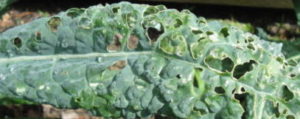
Dinosaur kale with caterpillar holes.
I use it on the brassicas (broccoli, kale, etc.) to prevent utter devastation by caterpillars. Not using it at all means more than just a few holes in the leaves. The leaves disappear!
It works on gypsy moths, canker worms, cabbage worms, cutworms, squash vine borers, tent caterpillars, and the “very hungry caterpillar” known as the tobacco hornworm, among others.
The tomato hornworm looks similar to the tobacco hornworm (photo, below), except it has V-shaped lines and a black “horn” instead of a red one. But, again, if you see entire tomato stems denuded of their leaves, look for that hornworm first before filling the sprayer. There might be only one or two on a large plant. (Tip: if you see their poop pellets, look above them.)
Different strains of Bt also control fungus gnats, potato beetles, mosquitoes, and nematodes.
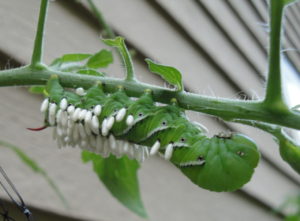
Tobacco hornworm with parasitic wasp pupae.
Braconid Wasps
This species of Braconid wasp, Cotesia congregata, will kill or severely weaken the tobacco hornworm (photo, above). First, a female wasp lays eggs on or in the caterpillar. After hatching, the wasp larvae feed on the caterpillar’s internal tissues, and then pupate in the white cocoons.
Although it looks menacing, there’s really no need to spray this one. Simply remove the weakened caterpillar to the shrubs. The adult wasps will emerge, and then a bird or a lizard might finish off the caterpillar. The adult form of the hornworm is a type of hawk moth.
Headings
Page 1: What’s All the Buzz About Pollinators? (The Fruits of Pollination), Honey Bees (Why All the Fuss About Pollinators?, Current Research), and So, What Can We Do About It? (To Spray Or Not To Spray, Try Using These, Bt, Braconid Wasps)
Page 2: Planting for Pollinators (For Bees, For Butterflies and Moths, For Hummingbirds), Pollinators In the Landscape (Plant Selection, Host Plants and Nectar Plants, The Importance of Native Plants for Pollinators, Water and Minerals, Shelter), Attracting Pollinators to Your Garden, and National Pollinator Week
